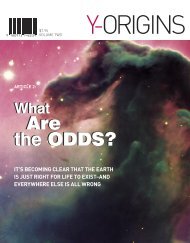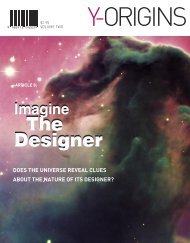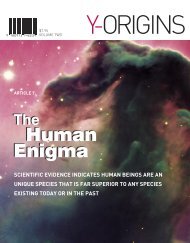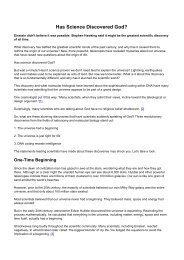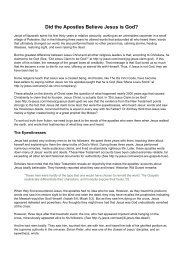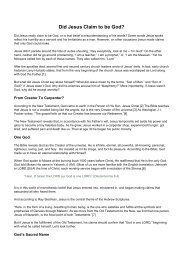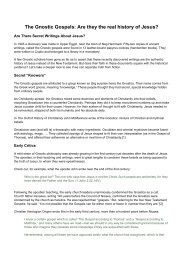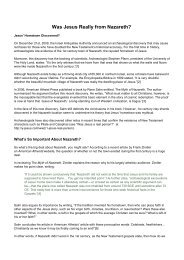missing_link6
You also want an ePaper? Increase the reach of your titles
YUMPU automatically turns print PDFs into web optimized ePapers that Google loves.
Morris suggests that life could not have<br />
been a mere product of time plus chance,<br />
as Darwin theorized. He sees design and<br />
purpose in biological structures, pondering:<br />
Does evolution have a structure, an<br />
overall design, perhaps even a purpose?<br />
Orthodox opinion recoils from this<br />
prospect. Evolution, it is widely believed,<br />
is an effectively random process where<br />
almost any outcome is possible. … We,<br />
like all other life, are an evolutionary<br />
accident. But is this correct? In fact the<br />
evidence points in exactly the opposite<br />
direction. 24<br />
Morris cites evidence of design patterns<br />
like the eye, that exist in unrelated phyla.<br />
How did each of these unrelated animal<br />
groups develop an eye, independent of one<br />
another? Morris believes there are common<br />
patterns built into nature’s laws. He calls<br />
his theory, convergence.<br />
According to Morris, such common design<br />
patterns in totally separate phyla provide<br />
compelling evidence against Darwin’s<br />
theory of accidental naturalistic evolution.<br />
But is designed evolution really an option<br />
if there is little or no fossil evidence to support<br />
macroevolution?<br />
Although, like Morris, many believe in<br />
some form of directed evolution, such<br />
theories don’t adequately explain the<br />
<strong>missing</strong> transitional fossils. Macroevolution,<br />
whether by design or by accident, still<br />
requires transitional forms. Yet the intense<br />
scrutiny of billions of fossils has failed to<br />
provide clear evidence for macroevolution<br />
other than a few debatable exceptions.<br />
What, then, is the most plausible explanation<br />
for the <strong>missing</strong> transitional forms?<br />
There are really only three viable options:<br />
1. Darwin was right about macroevolution.<br />
An abundance of transitional<br />
fossils will someday be found, or billions<br />
of transitionals were destroyed.<br />
2. Darwin was wrong about gradualism.<br />
Macroevolution occurred rapidly,<br />
explaining the <strong>missing</strong> transitions<br />
(punctuated equilibria or design).<br />
3. Darwin was wrong about macroevolution.<br />
The fossils can’t be found because<br />
transitions never existed (design).<br />
Paleontologists are not in agreement on<br />
which option is correct, but there is general<br />
agreement, with a few debatable exceptions,<br />
that the fossils that Darwin predicted<br />
would be discovered in abundance are truly<br />
<strong>missing</strong>. Materialists respond by showing<br />
fossil evidence of horses gradually evolving.<br />
But that is only microevolution.<br />
They also try to depict human evolution by<br />
assembling fragments of hominid skulls.<br />
But the origin of Homo sapiens has been a<br />
source of frustration and controversy. (See<br />
article 7)<br />
As we have seen, Darwinist’s best example,<br />
the Archaeopteryx, is a debatable transition<br />
between birds and reptiles. If Darwin<br />
was right, there should be millions of his<br />
“Biologists would be<br />
better off following<br />
the evidence<br />
wherever it leads.”<br />
12 • THE CASE OF THE MISSING LINK • ARTICLE 6




